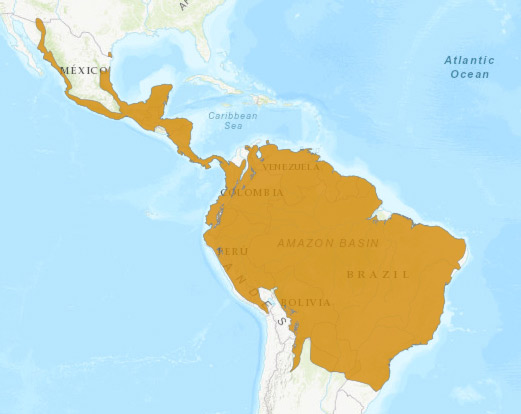Ocelot
Leopardus pardalis
©Adriano Gambarini
Taxonomy
Standard English Name
Ocelot
Scientific Name
Leopardus pardalis
Brazilian common name/s
Jaguatirica, Gato-maracajá-verdadeiro, Maracajá-açu
Conservation status - IUCN
Physical Description
One of the most popular cats in South America, it is a medium sized animal, measuring 95 to 140 cm long including the tail and weighing from 7 to 15 kg. It has thick pale golden yellow fur, with dark rosettes arranged mainly on the sides of the body. The rosettes on the back merge into stripes that run from the top of eyes to the base of the tail. They communicate by meowing.
Ecology and Habitat
Currently occurs in all of Latin America except Chile and was almost expatriated from the United States. They live in forests, grasslands, savannas and wetlands. Ocelots are solitary with predominantly nocturnal activity patterns. During the day, they sleep in hollow trees or shrubs. It has a great ability to climb trees, jump and swim. They are territorial, occupying, depending on the type of habitat, from 1 to 12 km².
It feeds mainly on wild animals, especially small rodents, but also birds, reptiles and other mammals.
The gestation period ranges from 70 to 80 days, with an average litter of 3 cubs. The cubs stay with their mother until they are approximately one year old.
Threats and Conservation
It was one of the most exploited cats for the fur trade. In Brazil, 80,000 skins were exported annually. With the law banning hunting this trade has declined and today the main threat to this feline is the destruction of their habitat. It is classified by the IUCN (International Union for Conservation of Nature) as vulnerable and by IBAMA, as threatened with extinction.
Online links
IUCN redlist (http://www.iucnredlist.org) presents a synthesis of current knowledge about distribution and conservation status.
IUCN Cat Specialist Group:
http://www.catsg.org/catsgportal/20_catsg-website/home/index_en.htm
IUCN Cat Specialist Group species accounts:
http://www.catsg.org/catsgportal/cat-website/20_cat-website/home/index_en.htm
References
Abreu, K. C., Moro-Rios, R. F., Silva-Pereira, J. E., Miranda, J. M. D., Jablonski, E. F., & Passos, F. C. (2008). Feeding habits of ocelot (Leopardus pardalis) in Southern Brazil. Mammalian Biology, 73, 407-411.
Caso, A., Lopez-Gonzalez, C., Payan, E., Eizirik, E., de Oliveira, T. G., Leite-Pitman, R., Kelly, M., & Valderrama, C. (2008). Leopardus pardalis. In: IUCN 2010. IUCN Red List of Threatened Species. Version 2010.2. <www.iucnredlist.org>, , Downloaded on 06 July 2010.
Di Bitetti, M. S., Paviolo, A., & De Angelo, C. (2006). Density, habitat use and activity patterns of ocelots (Leopardus pardalis) in the Atlantic Forest of Misiones, Argentina. Journal of Zoology, 270, 153-163.
Di Bitetti, M. S., Paviolo, A., De Angelo, C. D., & Di Blanco, Y. E. (2008). Local and continental correlates of the abundance of a neotropical cat, the ocelot (Leopardus pardalis). Journal of Tropical Ecology, 24, 189-200.
Dillon, A., & Kelly, M. J. (2008). Ocelot home range, overlap and density: comparing radio telemetry with camera trapping. Journal of Zoology, 275, 391-398.
Emmons, L. H., & Feer, F. (1997). Neotropical rainforest mammals: a field guide. Chicago: University of Chicago Press.
Goulart, F. V. B., Caceres, N. C., Graipel, M. E., Tortato, M. A., Ghizoni, I. R., & Oliveira-Santos, L. R. (2009). Habitat selection by large mammals in a southern Brazilian Atlantic Forest. Mammalian Biology, 74, 184-192.
Horne, J. S., Haines, A. M., Tewes, M. E., & Laack, L. L. (2009). Habitat partitioning by sympatric ocelots and bobcats: implications for recovery of ocelots in southern Texas. Southwestern Naturalist, 54, 119-126.
Jackson, V. L., Laack, L. L., & Zimmerman, E. G. (2005). Landscape metrics associated with habitat use by ocelots in south Texas. Journal of Wildlife Management, 69, 733-738.
Kolowski, J. M., & Alonso, A. (2010). Density and activity patterns of ocelots (Leopardus pardalis) in northern Peru and the impact of oil exploration activities. Biological Conservation, 143, 917-925.
Maffei, L., Noss, A. J., Cuellar, E., & Rumiz, D. I. (2005). Ocelot (Felis pardalis) population densities, activity, and ranging behaviour in the dry forests of eastern Bolivia: data from camera trapping. Journal of Tropical Ecology, 21, 349-353.
Martins, R., Quadros, J., & Mazzolli, M. (2008). Food habits and anthropic interference on the territorial marking activity of Puma concolor and Leopardus pardalis (Carnivora: Felidae) and other carnivores in the Jureia-Itatins Ecological Station, Sao Paulo, Brazil. Revista Brasileira de Zoologia, 25, 427-435.
Michalski, F., & Peres, C. A. (2005). Anthropogenic determinants of primate and carnivore local extinctions in a fragmented forest landscape of southern Amazonia. Biological Conservation, 124, 383-396.
Miranda, J. M. D., Bernardi, I. P., Abreu, K. C., & Passos, F. C. (2005). Predation on Alouatta guariba clamitans Cabrera (Primates, Atelidae) by Leopardus pardalis (Linnaeus) (Carnivora, Felidae). Revista Brasileira de Zoologia, 22, 793-795.
Moreno, R. S., Kays, R. W., & Samudio, R. (2006). Competitive release in diets of ocelot (Leopardus pardalis) and puma (Puma concolor) after jaguar (Panthera onca) decline. Journal of Mammalogy, 87, 808-816.
Murray, J. L., & Gardner, G. L. (1997). Leopardus pardalis. Mammalian Species, 548, 1-10.
Trolle, M., & Kery, M. (2003). Estimation of ocelot density in the pantanal using capture-recapture analysis of camera-trapping data. Journal of Mammalogy, 84, 607-614.
Wang, E. (2002). Diets of ocelots (Leopardus pardalis), margays (L-wiedii), and oncillas (L-tigrinus) in the Atlantic rainforest in southeast Brazil. Studies on Neotropical Fauna and Environment, 37, 207-212.
de Oliveira, T. G., Tortato, M. A., Silveira, L., Kasper, C. B., Mazim, F. D., Lucherini, M., Jácomo, A. T. A., Soares, J. B. G., Marques, R. V., & Sunquist, M. E. (2010). Ocelot ecology and its effect on the small-felid guild in the lowland Neotropics. In D. W. Macdonald & A. Loveridge (Eds.), Biology and Conservation of Wild Felids (pp. 563-584). Oxford: Oxford University Press.
